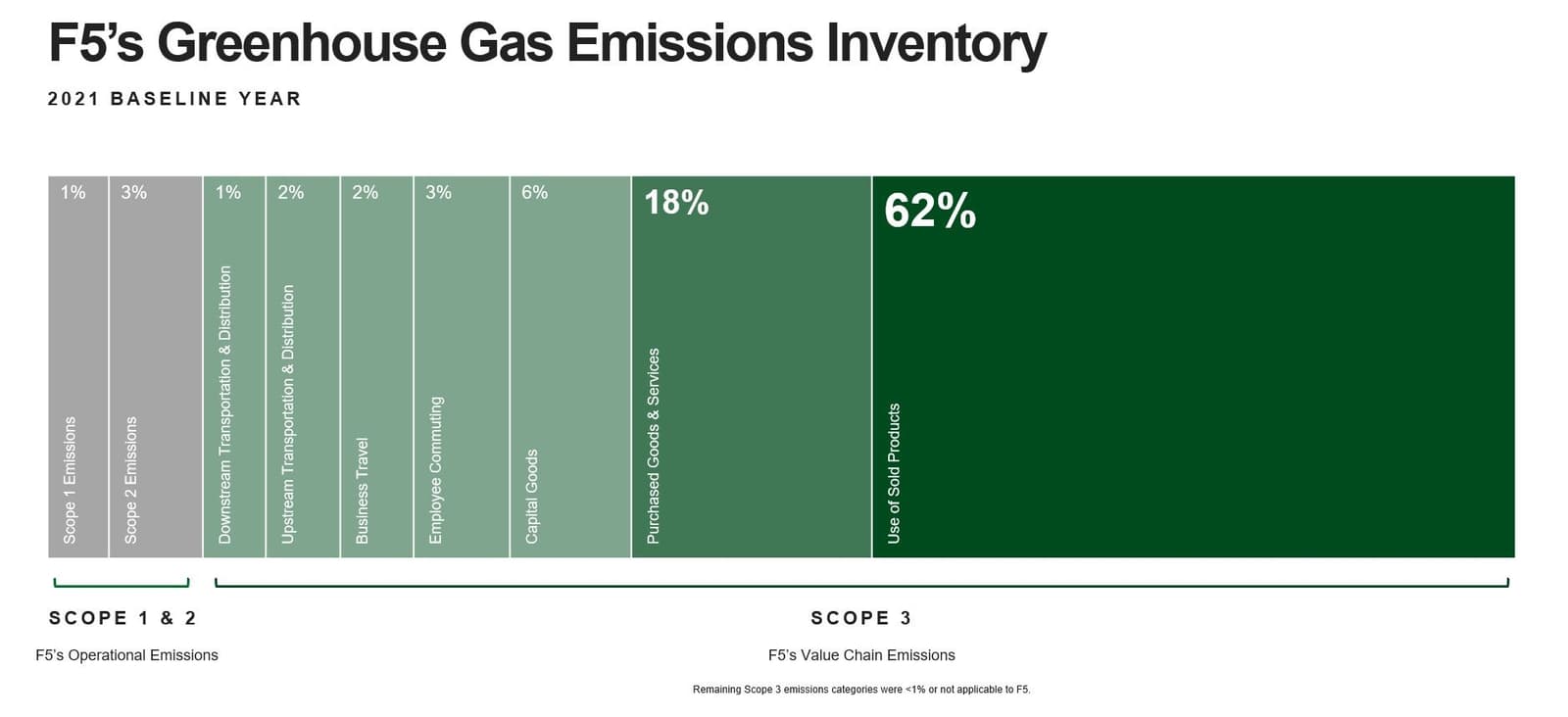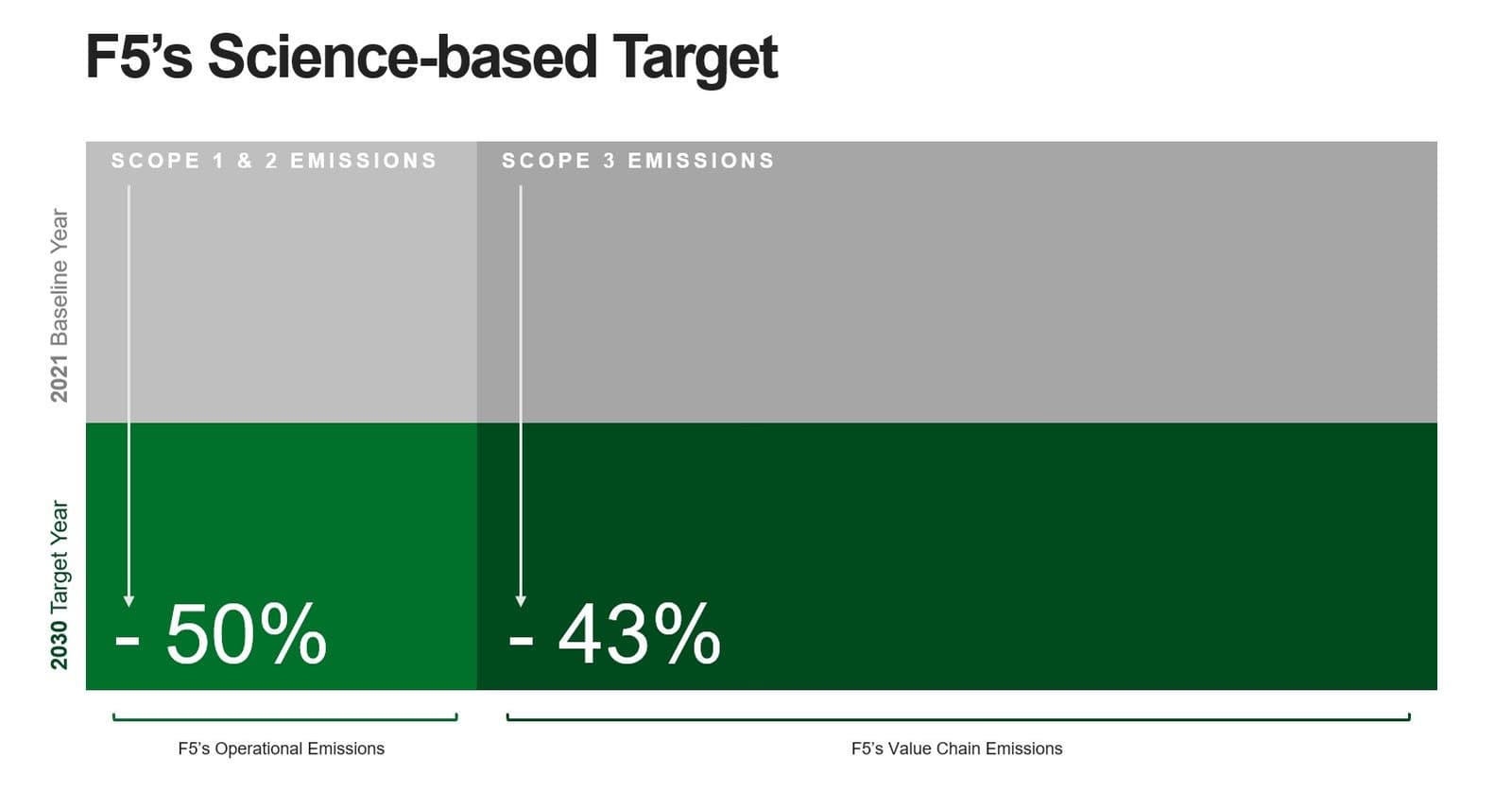Update: In August 2024, F5 received verification from the Science Based Target initiative (SBTi) that our target conforms to its standards in line with a 1.5°C trajectory. F5’s approved near-term climate target is listed on the Companies Taking Action section of the SBTi’s website.
Since F5 formed its Environmental, Social & Governance (ESG) team in late 2020, one of our biggest goals has been to set a science-based target to reduce F5’s greenhouse gas emissions. For a company that had an environmental policy but little else three years ago, this goal of ours could generously be called ambitious.
The Science Based Targets initiative (SBTi) is among the most rigorous and exacting types of climate target frameworks, intended to prevent the worst effects of climate change. To date, just under 3500 companies in the world have approved targets from the SBTi, and of those, less than 300 are Tech companies. For F5 to join this group, we knew it would take a major push to collect and assess emissions data across F5 and our value chain for the first time. Because like most companies, our operational emissions, called Scope 1 & 2, that come from our worldwide offices are relatively small. In contrast, the vast majority of our emissions come from our value chain, much of it outside our direct control, in what is called Scope 3.
We reached the first milestone towards our science-based target goal this time last year, when we committed to cutting our absolute Scope 1 & 2 emissions in half by 2030. Throughout 2023, we expanded upon that work to follow the SBTi’s target-setting framework and identified the biggest sources of our Scope 3 emissions.

As is typical for a company that straddles software, SaaS, and hardware, the category with the highest emissions volume overall comes from the use of our products. Every product and service we sell to our customers requires energy to operate, and the work we have ahead of us is to make our products and services more energy efficient and to transition to low(er)-carbon alternatives across our supply chain. While reducing the energy consumption of our products helps lower our emissions, more importantly, it also helps our customers reduce their energy consumption and costs.
The remainder of our emissions come from multiple categories at much lower volumes—again, a fairly typical distribution of emissions for a company of our scale in the Tech industry.
With this emissions inventory completed and analyzed, we could reach the second milestone towards our goal: setting a target that included our Scope 3 emissions and submitting our complete target to the SBTi for validation.
Now that the path we have in front of us to reduce F5’s environmental impact is clear, we are committed to a science-based target by 2030 from a 2021 baseline year that will:
- Reduce 50% of our Scope 1 & 2 emissions by sourcing more renewable energy and improving our offices’ energy efficiency.
- Reduce 43% of our Scope 3 emissions by prioritizing more sustainable design and energy performance in our products, followed by decarbonizing our supply chain.

The result of this target will be a significant reduction in F5’s overall emissions by the end of the decade, but equally, achieving a climate target of this magnitude will represent a true transformation of F5’s environmental impact on behalf of our communities, employees, customers, and shareholders.
If you’d like to chart our progress against these targets, please watch for our ESG report published annually on our ESG site or drop us a note at esgreport@f5.com and we will send you a copy directly.
About the Author

Related Blog Posts

AppViewX + F5: Automating and orchestrating app delivery
As an F5 ADSP Select partner, AppViewX works with F5 to deliver a centralized orchestration solution to manage app services across distributed environments.

Build a quantum-safe backbone for AI with F5 and NetApp
By deploying F5 and NetApp solutions, enterprises can meet the demands of AI workloads, while preparing for a quantum future.

F5 ADSP Partner Program streamlines adoption of F5 platform
The new F5 ADSP Partner Program creates a dynamic ecosystem that drives growth and success for our partners and customers.
F5 NGINX Gateway Fabric is a certified solution for Red Hat OpenShift
F5 collaborates with Red Hat to deliver a solution that combines the high-performance app delivery of F5 NGINX with Red Hat OpenShift’s enterprise Kubernetes capabilities.
F5 Silverline Mitigates Record-Breaking DDoS Attacks
Malicious attacks are increasing in scale and complexity, threatening to overwhelm and breach the internal resources of businesses globally. Often, these attacks combine high-volume traffic with stealthy, low-and-slow, application-targeted attack techniques, powered by either automated botnets or human-driven tools.
Phishing Attacks Soar 220% During COVID-19 Peak as Cybercriminal Opportunism Intensifies
David Warburton, author of the F5 Labs 2020 Phishing and Fraud Report, describes how fraudsters are adapting to the pandemic and maps out the trends ahead in this video, with summary comments.
